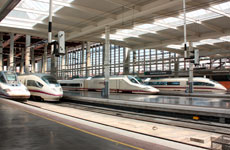
Categories
Publications
Reflections on the concept of high-speed network density
21/02/2017

The high-speed rail network density, whether it is related to the area or the population of a country, is sometimes used to judge its suitability to efficiently meet the mobility needs.
However, the usefulness of this indicator is not clear: firstly, because density in itself is of littlerelevance if it is not related to the distances, population distribution and other territorial indicators; and secondly because density must be measured for the whole network, not for some of its parts. In the case of Spain, the density of high-speed lines is high in comparison with that of other countries, but the whole network (in which high-speed lines are totally integrated) is still small, below half the global average and in values close to the ones reached in the past one hundred years. High-speed lines have come to replace lines that have been closed, keeping the network length and density similar.
In summary, the fact that the ratio between kilometres of high-speed lines in Spain and the area of the country is higher than the one in other countries does not mean inadequacy of the network or excessive performance, and it lacks any special sense. On the contrary, it can be said as this article shows, that high-speed lines in Spain have barely replaced closed lines in terms of length, so the density is still low. Nevertheless, the functionality, performance and traffic of the rail network have increased with the arrival of high speed.
Download paper »



